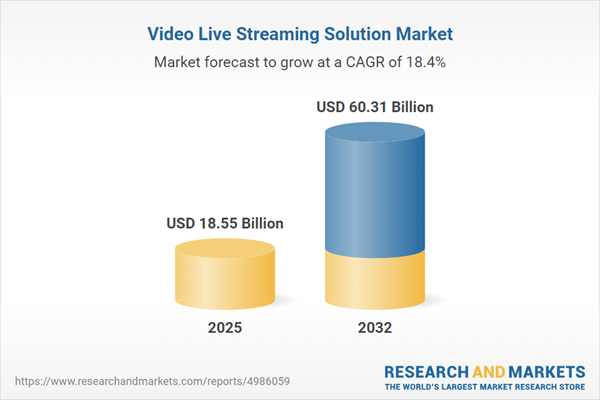Speak directly to the analyst to clarify any post sales queries you may have.
Enterprises are rapidly embracing video live streaming solutions to boost digital engagement, streamline internal operations, and diversify revenue streams. In today's competitive landscape, these platforms are essential for organizations seeking to connect meaningfully with audiences, enhance workforce training, and extend their market reach.
Market Snapshot: Video Live Streaming Solution Market
The Video Live Streaming Solution Market grew from USD 15.64 billion in 2024 to USD 18.55 billion in 2025. It is projected to achieve a CAGR of 18.37%, reaching USD 60.31 billion by 2032.
Scope & Segmentation
This report delivers an in-depth analysis of solution adoption, deployment models, user types, and application trends across leading regions and verticals.
- Solution Type: Analytics (QoS and viewer analytics); CDN; Encoding and transcoding engines; Live streaming platforms; Media services; Monetization (ad insertion, pay-per-view, subscription models)
- Deployment Type: Cloud; Hybrid (private and public cloud integration); On-premise
- End User: E-commerce and retail; E-learning (corporate training, self-paced learning, virtual classrooms); Gaming and esports; Healthcare and telemedicine; Media and entertainment
- Application: Live commerce (beauty, electronics, fashion); Live sports; Online courses (corporate training, K-12 virtual classrooms, MOOCs); Social streaming; Telemedicine (patient monitoring, remote consultation); Virtual events (conferences, product launches, webinars)
- Region: Americas (North America, Latin America); Europe, Middle East & Africa (Europe, Middle East, Africa); Asia-Pacific
- Key Companies Profiled: Amazon.com, Inc.; Microsoft Corporation; Google LLC; IBM Corporation; Akamai Technologies, Inc.; Tencent Holdings Limited; Alibaba Group Holding Limited; Edgio, Inc.; Brightcove Inc.; Kaltura Inc.
Key Takeaways for Senior Decision Makers
- Live video streaming solutions have evolved into a strategic necessity across sectors, supporting both audience acquisition and internal training while addressing modern business demands.
- The convergence of cloud computing, advanced content delivery, and low-latency encoding technologies is lowering entry barriers and enabling scalable, high-quality live streaming experiences for organizations of any size.
- Integrated analytics and monetization capabilities within unified platforms are pivotal for optimizing viewer engagement and unlocking new revenue channels such as advertising and subscription models.
- Modular, API-driven solutions allow for rapid integration with third-party services, offering agility in adapting to emerging technologies and shifts in user behavior.
- Differentiated regional strategies are essential; robust network infrastructures drive adoption in the Americas, while regulatory compliance and localized delivery are key in Europe, the Middle East, and Africa. Meanwhile, Asia-Pacific's mobile-first consumer base accelerates investment in edge and multi-CDN strategies.
Tariff Impact: Navigating Recent U.S. Equipment Tariffs
The imposition of new tariffs on video live streaming equipment in 2025 has generated supply chain headwinds. Manufacturers face increased costs for critical hardware components, prompting service providers and enterprises to reassess procurement approaches. Common responses include nearshoring partnerships, renegotiated vendor contracts, and accelerated adoption of software-defined infrastructure that reduces hardware dependency. These measures enable organizations to offset capital expenditure rises and retain deployment flexibility despite ongoing trade volatility.
Methodology & Data Sources
The report's insights are based on a rigorous research framework combining secondary data from technical publications and market reports with primary interviews of executives, technology specialists, and enterprise end users. Data validation included SWOT assessments, correlation mapping between deployment models and applications, and expert panel reviews to ensure accuracy and strategic relevance.
Why This Report Matters
- Identify the optimal combination of technologies and deployment models to drive operational agility and maximize engagement across diverse business units.
- Understand the critical impacts of tariffs, supply chain strategies, and regulatory dynamics on sourcing and equipment investment.
- Gain actionable insights to inform vendor selection, ecosystem partnerships, and innovation roadmaps tailored to future growth opportunities.
Conclusion
With live video streaming solutions central to digital transformation, organizations must align platform capabilities, regional strategies, and monetization frameworks to maintain a competitive market position and harness emerging growth pathways.
Additional Product Information:
- Purchase of this report includes 1 year online access with quarterly updates.
- This report can be updated on request. Please contact our Customer Experience team using the Ask a Question widget on our website.
Table of Contents
3. Executive Summary
4. Market Overview
7. Cumulative Impact of Artificial Intelligence 2025
Companies Mentioned
The companies profiled in this Video Live Streaming Solution market report include:- Amazon.com, Inc.
- Microsoft Corporation
- Google LLC
- IBM Corporation
- Akamai Technologies, Inc.
- Tencent Holdings Limited
- Alibaba Group Holding Limited
- Edgio, Inc.
- Brightcove Inc.
- Kaltura Inc.
Table Information
| Report Attribute | Details |
|---|---|
| No. of Pages | 185 |
| Published | November 2025 |
| Forecast Period | 2025 - 2032 |
| Estimated Market Value ( USD | $ 18.55 Billion |
| Forecasted Market Value ( USD | $ 60.31 Billion |
| Compound Annual Growth Rate | 18.3% |
| Regions Covered | Global |
| No. of Companies Mentioned | 11 |









